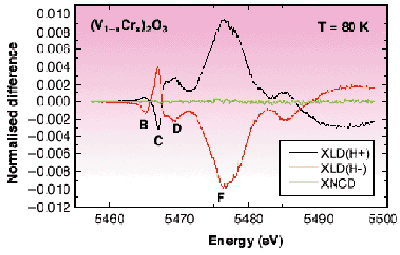- Home
- Users & Science
- Scientific Documentation
- ESRF Highlights
- ESRF Highlights 2000
- Magnetism
- First Observation of Nonreciprocal X-ray Gyrotropy
First Observation of Nonreciprocal X-ray Gyrotropy
In optics, gyrotropy and optical activity are closely related tensor properties, which describe spatial dispersion effects, i.e. the breakdown of the usual electric dipole approximation in radiation-matter interactions. Typically, the time-reversal even, imaginary part of the complex gyrotropy tensor ![]() * is responsible for reciprocal effects such as natural circular dichroism or optical rotation. X-ray natural circular dichroism (XNCD), i.e. a differential absorption of left- and right-handed circularly polarised X-rays, has long been sought in compounds which lack inversion symmetry but was measured only recently at the ESRF [1]. Here, we are concerned with a nonreciprocal X-ray linear dichroism (XLD), i.e. a differential absorption of the (
* is responsible for reciprocal effects such as natural circular dichroism or optical rotation. X-ray natural circular dichroism (XNCD), i.e. a differential absorption of left- and right-handed circularly polarised X-rays, has long been sought in compounds which lack inversion symmetry but was measured only recently at the ESRF [1]. Here, we are concerned with a nonreciprocal X-ray linear dichroism (XLD), i.e. a differential absorption of the (![]() ,
, ![]() ) components of linearly polarised X-rays: this new effect refers to the time-reversal odd, real part of
) components of linearly polarised X-rays: this new effect refers to the time-reversal odd, real part of ![]() * and can only be observed in magnetic media in which inversion symmetry is still broken, but now as a consequence of antiferromagnetic order. X-rays offer the remarkable peculiarity that
* and can only be observed in magnetic media in which inversion symmetry is still broken, but now as a consequence of antiferromagnetic order. X-rays offer the remarkable peculiarity that ![]() * is fully dominated by the electric dipole (E1) and electric quadrupole (E2) interference terms: this is not true in the UV-visible energy range where
* is fully dominated by the electric dipole (E1) and electric quadrupole (E2) interference terms: this is not true in the UV-visible energy range where ![]() * is mostly controlled by electric dipole (E1), magnetic dipole (M1) interferences. One may therefore anticipate that the information contents of gyrotropy effects detected using X-rays or at optical wavelengths should be complementary.
* is mostly controlled by electric dipole (E1), magnetic dipole (M1) interferences. One may therefore anticipate that the information contents of gyrotropy effects detected using X-rays or at optical wavelengths should be complementary.
We succeeded in measuring a nonreciprocal transverse anisotropy in the low temperature, antiferromagnetic, insulating (AFI) phase of a Cr doped V2O3 crystal in which one single antiferromagnetic domain was grown by magnetoelectric annealing. In this phase, the magnetic moments (1.2 µB per V atom) are rotated by 71° with respect to the hexagonal c axis aligned along the direction of propagation of the X-rays. The space-time group A2 reflects a low symmetry due to induced magnetic moments on oxygen atoms: space-time inversion is broken and the crystal is magnetoelectric. Our experiments were performed at beamline ID12A: a 1/4 wave plate was used to convert circularly polarised X-rays into linearly polarised rays with the capability to flip the polarisation vector rapidly in the orthogonal directions. XLD spectra recorded at the V K-edge after magnetoelectric annealing are reproduced in Figure 85: the amplitude of the nonreciprocal XLD signal (ca. ± 1%) is much bigger than what could be measured at optical wavelengths. As expected for a time-reversal odd effect, the sign of the dichroism is inverted when the electric and magnetic fields are either parallel or antiparallel. This is the unambiguous proof that nonreciprocal XLD is inherently different from conventional X-ray magnetic linear dichroism experiments in which the magnetic anisotropy is proportional to [M2] and remains unchanged when the direction of the magnetic field is inverted. Although the local point group (C3) at each metal centre is chiral, note that there is no detectable average XNCD signal because the space group I2/a belongs to a centrosymmetric crystal class: this is further evidence that inversion symmetry is broken here only as a consequence of antiferromagnetic order.
 |
Fig. 85: Nonreciprocal XLD spectra recorded in the AFI phase of a single crystal of (V 1xCr x) 2O 3. Magnetoelectric annealing was performed with parallel (+) and antiparallel (-) electric and magnetic fields. The XNCD spectrum plotted on the same scale is hardly visible.
|
Recall that the observation of E1E2 gyrotropy signals implies a substantial parity mixing between the 3d - 4p metal orbitals. One may hope to learn more about orbital occupancy using the new sum rules established by Carra and Benoist [2]. An interesting outcome of their theory is that [L] is no longer a suitable operator for describing the electronic and magnetic properties of noncentrosymmetric antiferromagnets.
References
[1] J. Goulon, C. Goulon-Ginet, A. Rogalev, V. Gotte, C. Malgrange, C. Brouder and C.R. Natoli, J. Chem. Phys. 108, 6394-6403, (1998).
[2] P. Carra and R. Benoist, Phys. Rev. B 62, R7703-06, (2000).
Principal Publication and Authors
J. Goulon (a), A. Rogalev (a), C. Goulon-Ginet (b), G. Benayoun (a), L. Paolasini (a), C. Brouder (c), C. Malgrange (c), and P.A. Metcalf (d), Phys. Rev. Lett. 85, 4385-4388 (2000).
(a) ESRF
(b) Université J. Fourier, Grenoble (France)
(c) Universités de Paris VI et VII, Paris (France)
(d) Purdue University, Indiana (USA)



